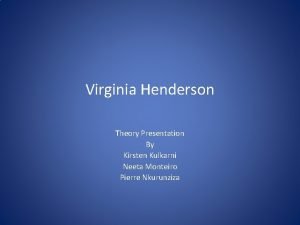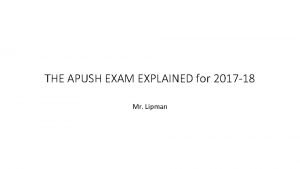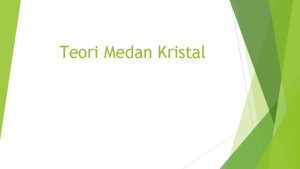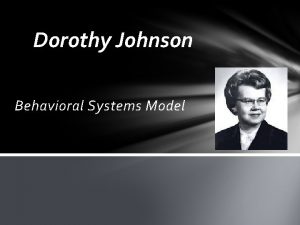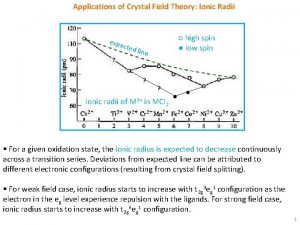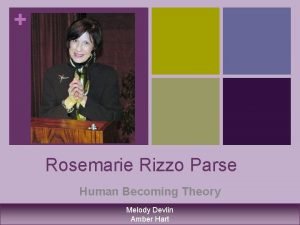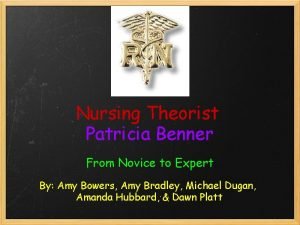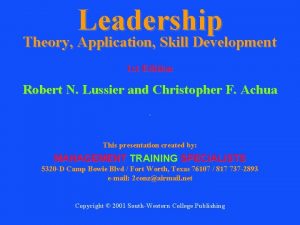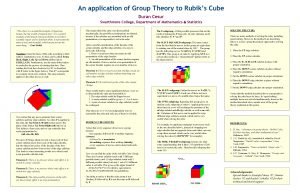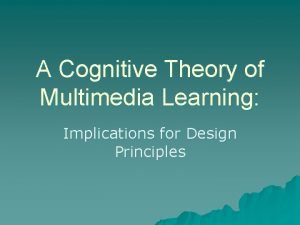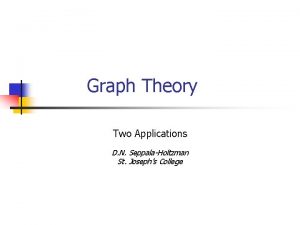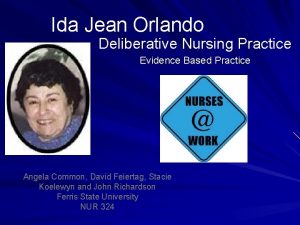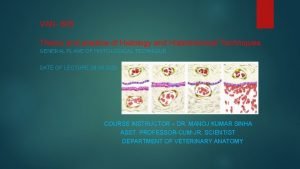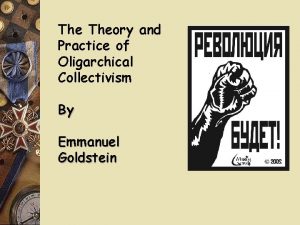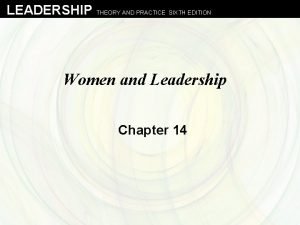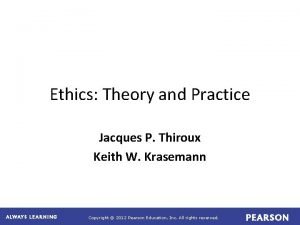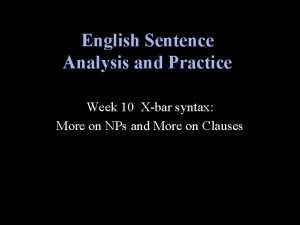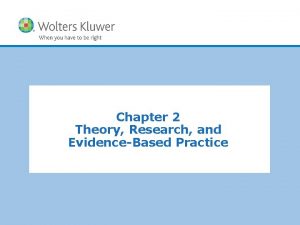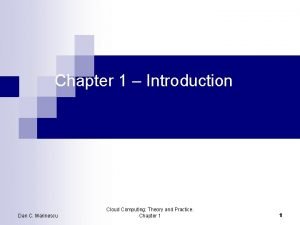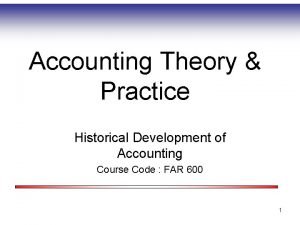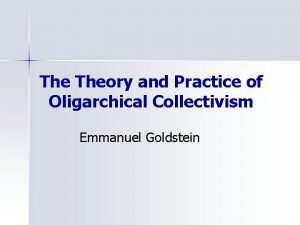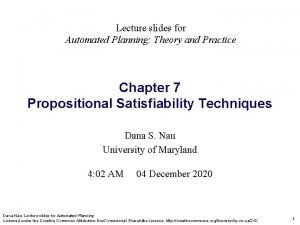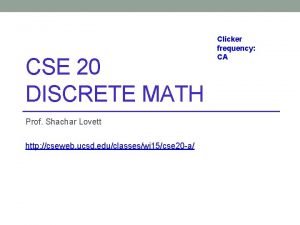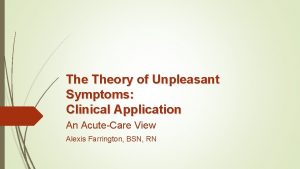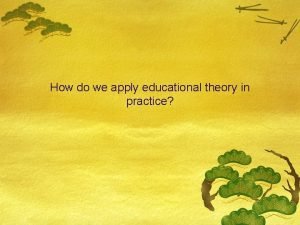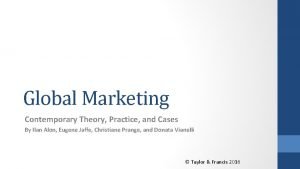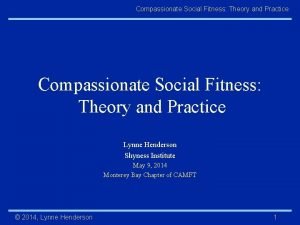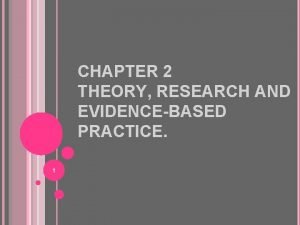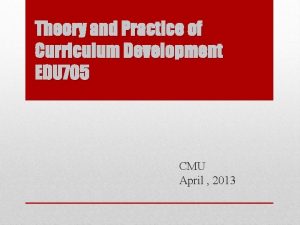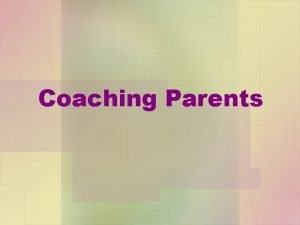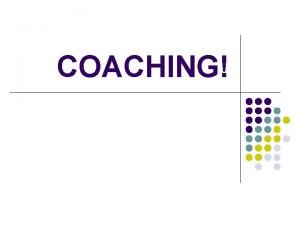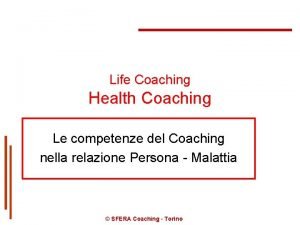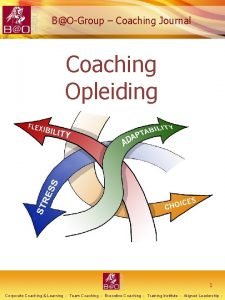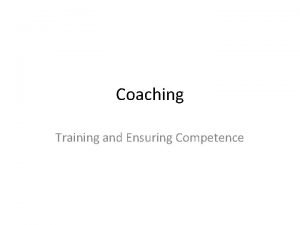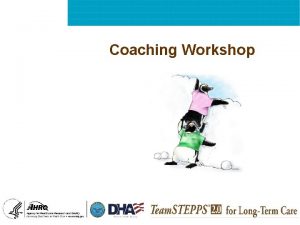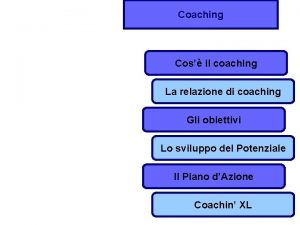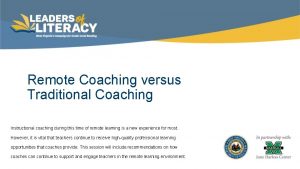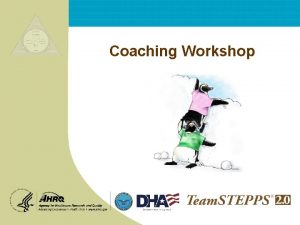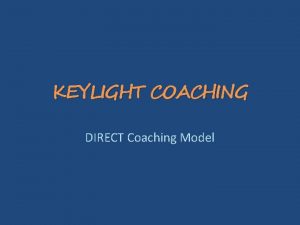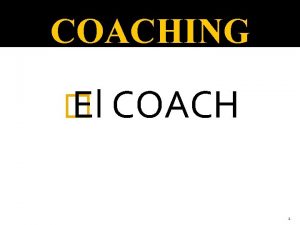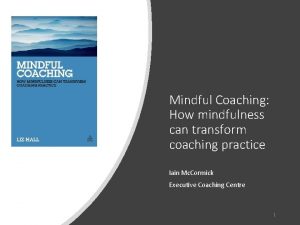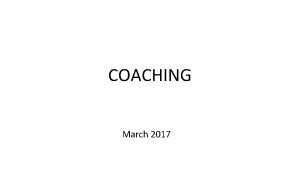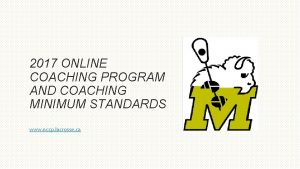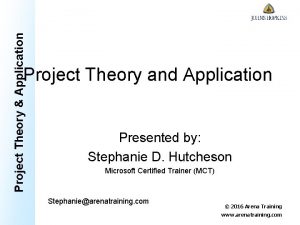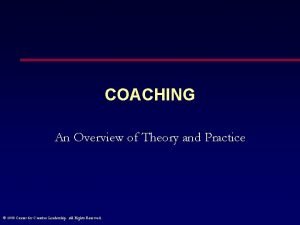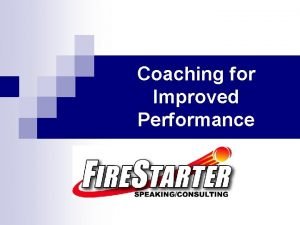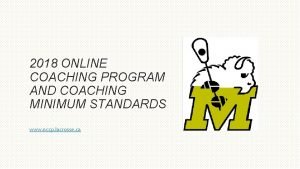2017 Coaching From Theory to Practice Application of






































- Slides: 38

2017

Coaching: From Theory to Practice Application of accepted coaching principles to Rider. Coach practices 2017

Shared at: This document is shared at: https: //tinyurl. com/y 8 fk 4 tjg 2017

Why do this? The quotes and excerpts which follow were drawn from books, papers, and published interviews, with accepted experts in fields of coaching. Their writings can be accepted as fact. Our task is to develop ways to apply these ideas to our coaching efforts. A lot of reading and research yielded this collection: 2017

The use of experts as models appears to encourage more the process of imitation than true learning through observation. (Bandura 1986, p. 48) 2017

Observation of the learning model while also receiving the model's augmented feedback resulted in the best observational learning. (Mc. Cullagh & Meyer, 1993) 2017

There are four types of practice: • Variable - the skill is practiced in the range of situations that could be experienced Open skills are best practiced in this way • Fixed - a specific movement is practiced repeatedly, known as a drill - Closed skills are best practiced in this way • Massed - a skill is practiced without a break until the skill is developed. Suitable when the skill is simple, motivation is high, purpose is to practice a skill, the learners are experienced • Distributed - breaks are taken whilst developing the skill. Suitable when the skill is new or complex, fatigue could result in injury, motivation is low, poor environmental conditions Distributed practice is considered to be the most effective. (http: //www. brianmac. co. uk/articles/scni 9 a 1. htm) 2017

This sound, called a 'tag', marks a single response, action or position called a tag point, and says, "Yes, that's correct". No click means, "Self-assess and try again". The feedback is positive and students do not have to interpret verbal instructions or corrections while trying to interpret their own intrinsic feedback. With TAGteach, the coach chooses and tags for the point that is sequentially most important to the make-up of the skill. Finally, because tag points are broken down into easily recognizable bits with simple yes or no answers, learners can become the 'coach' and tag each other. We call this 'peer tagging'. Participants instantly fill with a sense of responsibility and pride as they are handed a tagger and put in charge of deciding if the tag point was performed or not. They learn to look for correct actions in their partner, while mentally reinforcing the same points within themselves. The student who teaches-learns twice. (http: //www. brianmac. co. uk/articles/scni 37 a 1. htm) Theresa Mc. Keon 2017

Coaching is as much about the way these things are done as about what is done. Coaching delivers results in large measure because of the supportive relationship between the coach and the coachee, and the means and style of communication used. The coachee does acquire facts, but not from the coach, but from within himself, stimulated by the coach. Coaching for Performance Second Edition 1996, John Whitmore 2017

A learner can experience relaxation in learning a task when their skill level is very high and the task challenge is very low. Conversely, a learner can experience anxiety when their skill level is very low and the task challenge is very high. Neither state is supportive of optimal learning. Flow is the most optimal of these states for learning, as it is where skill level and challenge level of a task are at their highest. This creates an opportunity for learning and intense focus, where learners can even feel that they lose track of time because they are so immersed in the task. Csíkszentmihályi, M. (1996). Flow and the psychology of discovery and invention. New York: Harper Collins. Chicago 2017

Coaching is as much about the way these things are done as about what is done. Coaching delivers results in large measure because of the supportive relationship between the coach and the coachee, and the means and style of communication used. The coachee does acquire facts, but not from the coach, but from within himself, stimulated by the coach. Coaching for Performance Second Edition 1996, John Whitmore 2017

The chunking takes place in three dimensions. First, the participants look at the task as a whole - as one big chunk, the megacircuit. Second, they divide it into its smallest possible chunks. Third, they play with time, slowing the action down, then speeding it up, to learn its inner architecture. Coyle 2017

Coaching is unlocking a person’s potential to maximize their own performance. It is helping them to learn, rather than teaching them. Timothy Gallwey 2017

To use coaching successfully, we have to adopt a far more optimistic view than usual of the dormant capability of people, all people. Whitmore 2017

A coach is not a problem solver, a teacher, an adviser, an instructor, or even an expert; he or she is a sounding board, a facilitator, a counsellor, an awareness raiser. Whitmore 2017

Another aspect of the timing of feedback is the frequency of giving feedback. Common sense would say that the higher the frequency the better. Surely 100 percent frequency is best? Research has failed to support this. One of the problems with giving feedback after every trial is that the learner becomes dependent on the coach. Mc. Morris 2017

Does a coach need to have experience or technical knowledge in the area in which he is coaching? No - not if the coach is truly acting as a detached awareness raiser. If however, the coach does not fully believe in what he espouses, i. e. the potential of the performer and the value of self-responsibility, then he will think that he needs expertise in the subject to able to coach. Whitmore 2017

Questions should follow the interest and train of thought of the coachee, not of the coach. If the coach leads the direction of the questions, he will undermine the responsibility of the coachee. Whitmore 2017

We think of effortless performance as being desirable, but it is really a terrible way to learn. Deep practice is built on a paradox: struggling in certain targeted ways operating at the edges of your ability, where you make mistakes - makes you smarter. Or to put it a slightly different way, experiences where you are forced to slow down, make errors, and correct them - end up making you swift and graceful without you realizing it. Robert Bjork, Talent Code by daniel Coyle 2017

Words used to describe most productive practice: Attention, Connect, Build, Whole, Alert, Focus, Mistake, Repeat, Tiring, Edge, Awake. Words notably NOT used: Natural, Effortless, Routine, Automatic, Genius. Coyle 2017

Had the majority of Coach Wooden’s corrective strategies been positive (“Good job”) or negative (“No, that’s not the way”), I would have been left with an evaluation, not a solution. Also, corrections in the form of information did not address, or attack me as a person. New information was aimed at the act, rather than the actor. (S. Nater, personal communication, February 3, 2003) 2017

a three-part sequence of reproofs/scolds and modeling that were often combined and blended into a distinctive pattern…. The majority of Wooden’s scolds are embedded with instructions, . . . These are combination, complex statements in which the Coach simultaneously scolds and then specifically re instructs: “I have been telling some of you for three years not to wind up when you pass the ball: Pass from the chest!” Perhaps the example of greatest artistry is his use of modeling. His demonstrations are rarely longer than 3 seconds, but are of such clarity that they leave an image in memory much like a text-book sketch. This modeling most often takes place during patterned offense drills, or half-court scrimmage, when Wooden will whistle-down play, demonstrate the correct way to perform an act (M+), and then imitate the incorrect way the player has just performed(M-). He then remodels the M+. This sequence of M+, M-, M+ is Wooden’s typical pattern, and appears to be an extraordinarily effective way of providing both feedback and discrimination training. Our category of the Wooden is called by the Coach himself a “sandwich approach. ” (Tharp & Gallimore, unpublished manuscript, 1975) 2017

These people are not average teachers. . . they are merely disguised as average because their crucial skill does not show up on conventional measures of teaching ability. They are creating and sustaining motivation… The effect of this first phase of learning seemed to be to get the learner involved, captivated, hooked, and to get the learner to need and want more information and expertise. These teachers gave much positive reinforcement and only rarely were critical. . . they did set standards and expected… progress, although this was largely done with approval and praise. (Bloom) 2017

Great teachers focus on what the student is saying or doing, and are able, by being so focused and by their deep knowledge of the subject matter, to see and recognize the inarticulate stumbling, fumbling effort of the student who’s reaching toward mastery, and the connect to them with a targeted message. (Gallimore) 2017

A great teacher has the capacity to always take it deeper, to see the learning the student is capable of and go there. It keeps going deeper and deeper because the teacher can think about the material in so many different ways, and because there’s an endless number of connections they can make. (Gallimore) 2017

Information processing theorists claim that we can only handle 7 +/- 2 bits of information at any one time. Given all that (a rider) has to think about and all of the other thoughts vying for attention, it is best if instructions are very limited. (Coaching Science, Theory into Practice, Mc. Morris & Hale) 2017

Day dreaming is a form of mental rehearsal. (Mc. Morris & Hale) 2017

When arousal* level is low, people attend to too much information or cues and attend to irrelevant as well as relevant cues. As arousal rises, attention reaches an optimal level, when only relevant cues are processed. If arousal continues to rise however, attention will narrow further and even relevant cues will be missed. (Easterbrook) *Arousal: The physiological and/or cognitive readiness to act (Mc. Morris/Hale) 2017

Cooperative coaches are high in self-esteem and are able to empathise with their (learners). One would have to have high self-esteem to let the (learners) have major say. Cooperative coaches are willing to take a backseat and not be in the limelight. Command coaches are low in self-esteem and low in ability to empathise with their (learners). Command style coaches will try to take praise for performance of their (learners). (Martens) 2017

The Command style can be necessary if discipline is an issue. The command style allows the coach to remain in charge. This may be necessary if the task is a dangerous one. While Guided Discovery gets the learners to think their way through a problem, it may not be best with tasks that have an element of risk. (Mc. Morris/Hale) 2017

In (mixed group) situations, it may be safer to assume that all of the learning styles are represented; therefore, variety in your use of style will help. 2017

Learning is a relatively permanent change in performance resulting from practice or past experience. On cannot claim to have really learned a skill until one can perform it consistently. Performance is a temporary occurrence fluctuating from time to time: something which is transitory. Consistency can only come about by practice or experience. It is the role of the coach to ensure that his or her learners practice sufficiently to obtain that consistency. (Kerr 1982) 2017

We can, and do, improve our level of expertise simply by repeating a task, even when we are not consciously attending to what we are doing. implicit learning (Magill, Masters) 2017

Research has shown that we do not have to practice physically in order for learning to be demonstrated. Mental rehearsal can also result in learning. Mental rehearsal only works in conjunction with physical rehearsal. Research has shown that individuals who use mental rehearsal, as well as physical rehearsal, do learn more quickly than those using physical practice only. 2017

Performance immediately following practice is best when blocked practice (one skill) is used. With random and serial practice, it is likely that performing the other skills has a negative effect. However, when a retention test is undertaken, random and serial practice produce better results than blocked practice. Contextual interference effect. (Battig) 2017

One of the most important roles of the coach is to present feedback. Boht information processing theorists and ecological psychologists believe that the presence of coaches is a major aid to learning. While the coach is not the only person able to help the learner, they are likely to be the most knowledgeable and the best trained. (Mc. Morris, Hale) 2017

The good coach will take into account the fact that different learners have different abilities and will, therefore, perform the same skill differently. Bad coaches often miss this fact. Poor coaches will try to get everyone performing a skill in exactly the same way. (Mc. Morris, Hale) 2017

Bibliography (partial) Mc. Morris T. , Hale T. (2006) Coaching Science. West Sussex. John Wiley & Sons Whitmore J. (1996) Coaching for Performance. London. Nicholas Beardsley Publishing Coyle D. (2010) The Talent Code. New York. Random House Mac. Kenzie, B. (2004) Coaching Methods [WWW] Available from: https: //www. brianmac. co. uk/articles/scni 9 a 1. htm Mc. Keon, T. (2006) Eliminate nagging with tagging [WWW] Available from: https: //www. brianmac. co. uk/articles/scni 37 a 1. htm Hunter, D. (2006) Teaching & Coaching - is there a difference? [WWW] Available from: https: //www. brianmac. co. uk/articles/article 017. htm 2017
 Coaching theory and practice
Coaching theory and practice Henderson's 14 activities for client assistance
Henderson's 14 activities for client assistance Apush exam 2017
Apush exam 2017 2017 ap chemistry practice exam
2017 ap chemistry practice exam 2017 asco oncology practice conference
2017 asco oncology practice conference Myeplg
Myeplg Energi penstabilan medan kristal
Energi penstabilan medan kristal Jean piaget theory application
Jean piaget theory application Dorothy johnson theory application in nursing
Dorothy johnson theory application in nursing Crystal field effect on ionic radii
Crystal field effect on ionic radii Symbols of the human becoming theory
Symbols of the human becoming theory Patricia benner nursing theory application
Patricia benner nursing theory application Martha rogers' theory application
Martha rogers' theory application Margaret newman background
Margaret newman background Behavioral leadership theories attempt to explain
Behavioral leadership theories attempt to explain Application of group theory in rubik's cube
Application of group theory in rubik's cube Cognitive theory of multimedia learning
Cognitive theory of multimedia learning Application of graph theory
Application of graph theory Ida orlando theory
Ida orlando theory Theory and practice of histotechnology
Theory and practice of histotechnology The theory and practice of oligarchical collectivism
The theory and practice of oligarchical collectivism Leadership theory and practice 6th edition
Leadership theory and practice 6th edition Thiroux ethics theory and practice
Thiroux ethics theory and practice Extending x-bar theory to functional categories
Extending x-bar theory to functional categories Theory research and evidence based practice
Theory research and evidence based practice Cloud computing theory and practice
Cloud computing theory and practice Accounting theory and practice notes
Accounting theory and practice notes The theory and practice of oligarchical collectivism
The theory and practice of oligarchical collectivism Software testing and quality assurance: theory and practice
Software testing and quality assurance: theory and practice Automated planning theory and practice
Automated planning theory and practice Educational psychology chapter 1
Educational psychology chapter 1 Set theory practice
Set theory practice Theory of unpleasant symptoms
Theory of unpleasant symptoms What is text linguistics
What is text linguistics Applying educational theory in practice
Applying educational theory in practice Alon global marketing download
Alon global marketing download Compassion theory
Compassion theory Evidence based theory
Evidence based theory Curriculum development theory and practice
Curriculum development theory and practice

